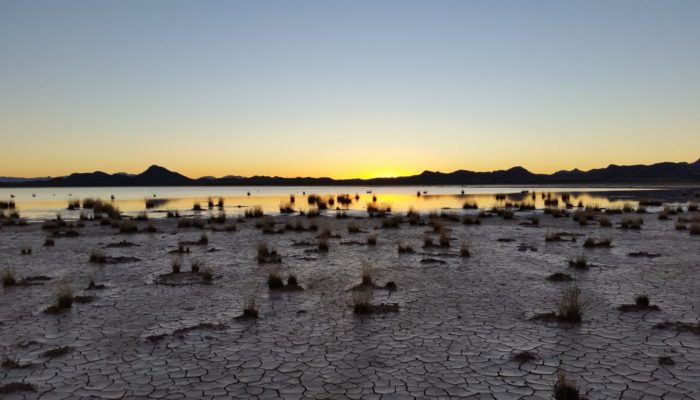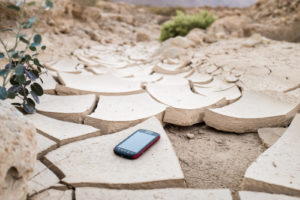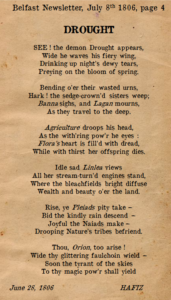
“If you see me, then weep”
Like the foreboding inscription witnessed by Dante as he passed through the gates of Hell, the inscription chiselled into the so-called “hunger stone” marks the passing of a threshold into suffering. As the hunger stone emerges from the dwindling waters of the Elbe River, Czechia, it reveals a history of desiccation. Where spiritual torment is promised at Hell’s vestibule, the hunger stone acts an augur for a period of a deficient harvest and communal suffering, brought on by a land is wracked by drought.
The hunger stone commemorates such periods of desiccation as far back as 1616, but the magnitude and frequency of the droughts which afflict modern Europe may leave this record of misery in the dust. In the summer of 2022, two thirds of Europe withered under the worst drought in 500 years, triggering declines in crop yields, an above-average wildfire season, and the depletion of hydropower on an already energy-stressed continent. But the 2022 drought is the latest of many: since 2003 more than half the years were drought years.
And yet drought remains a hazard under-served by the imagination, its risk devalued compared to other hazards like flooding and storms. This lesser appreciation can have a deadly consequence: the public may be underprepared or unaware of how they should act under drought conditions, whilst policy- and decision-makers de-prioritize its position in risk mitigation strategies.
Given the threat it poses, why does drought hold such a loose grip on how we perceive its risk?
The reasons for this are numerous and complex. A recent study published this year in the European Geosciences Union’s open access journal Natural Hazards and Earth System Sciences, found that perceptions of drought across Europe are highly variable: opinions on what characterizes drought, its impacts, and how it should be managed changes geographically across the continent. The reasons for this may not be intuitive either: people’s perception of risk frequently does not correlate with the severity the hazard or the expert assessment of risk.
Despite this complexity, the reasons why drought is depreciated and how this perception may be changed can be understood by using four keys.
Key One: A Dry Subject
The first key is spectacle. Simply, drought lacks razzle dazzle. Volcanism, storms, earthquakes, and flooding are the hazards-de-jour of disaster films. They all present immediate and dynamic dangers. But how often does the parching of land make for an exciting obstacle? Beyond a few exceptional representations in the media – the scarcity of Steinbeck’s 1939 The Grapes of Wrath is perhaps still its most iconic depiction – drought appears under-represented. It has a weak psychic grip on our imagination.
In part, the reason for this is the obvious:
Where hazards like flooding are an oppressive presence, drought is a subtle force defined by its absence.
Floodwaters are visible, extreme, and immediate. Drought is diffuse, invisible, and creeping, with the start of a drought impossible to determine. Similarly, drought is also spatially vague: where flooding is discrete and spatially confined, drought can spread across large regions without any clear boundary.
Spectacle strongly influences how people view their own risk: visible and immediate events are taken more seriously. Unlike the characteristic presence of other natural hazards, the insubstantial nature of drought makes it difficult to be captured by the mind’s eye.
Key Two: The Spectre of Drought
Our second key is time. The sudden rupture of the ground from an earthquake or the thunderous anvil of a storm looming above the horizon both make them easier to characterize in space and time. But drought is a slow burn, inveigling itself into the environment with an unclear beginning and end.

Drought – a prerequisite for hazardous flash floods. Credit: Stefan Schmitt (distributed via imaggeo.egu.eu)
Where the foot-print of a storm on the land may be understood by the path it takes, the shadow of drought is less discernible. Drought has many different forms, each moulded by the time-frame over which the hazard persists. Drought may range from a dearth of rainfall that defines the faster oncoming meteorological drought, to the drying up of water supply that accompanies prolonged hydrological drought. The changing way in which drought develops over time combined with its diffuse presence makes it difficult to demarcate.
The struggle of understanding when and how a drought is occurring is the struggle of capturing the invisible, like a ghost hunter locating a poltergeist by studying how the crockery has shattered.
Key Three: Stealth Desiccator
Our third key is hidden impacts. The creeping characteristic of drought translates into its impacts, leading to an under-estimation of its risk; where a hazard is pernicious so is its effect.
Like the slow burn through which drought manifests, time also influences how communities and ecosystems are impacted. Focusing just on the economic damages, major natural disasters resulting from hurricanes and earthquakes lower productivity, resulting in lower GDP growth in the following years as nations recover damaged infrastructures and hamstrung industries. By comparison, drought has a much more gradual cost which is spread over time.
Using the same time frame to compare the impact of a hurricane and a drought, one might see drought as the lesser risk; immediately after a drought, GDP growth typically only dips by a few points and its impacts are largely contained to the agricultural sector. Only if a drought persists does its impact manifest in the public water supply as hydrological drought emerges. If experience is the arbiter of the public’s perception, then a short-term drought is unlikely to grip the public’s consciousness as an ostensibly more impactful flood-event of the same duration.
But the danger of drought is in its frequency: far more common than earthquakes and hurricanes, the cost of underestimating drought is its cumulative curtailing of economic growth.
Long-term droughts degrade the land, damaging agricultural production and triggering migration. This guts regions of their labour force, reducing their trade capacity as exports decrease and imports rise. The recurrent cost of drought manifests as a gradual rise in public debt, risking inflation as governments look to monetary solutions. Where other hazards rip up the socio-economic tapestry, drought creeps in, gnawing through its fibers almost unnoticed until cohesion is lost and the structure unfurls.
Whilst the impact of drought can be lost in the account balance compared to more dynamic and immediate hazards, their impacts can be considerable. As droughts persist the land degrades, it heralds a decline in both ecosystem biodiversity and agricultural productivity. The long-term effect means drought ranks as one of the costliest natural hazards: as of 2022, droughts cost the European Union €9 billion (£7.7 billion) a year. If rising mean global temperatures reach 2°C, then the economic costs will triple. Since 1900, over 11 million people have died and over 2 billion people impacted. By 2050, 4 billion people will suffer from a lack of water.
Key Four: Lenses of Belief
The final key is personal perception, the lenses coloured by experience and culture which influence how we process and understand phenomena. This is most evident when we explore the patterns of perception shaped by those who have been impacted. Some of the patterns are obvious: those who have previously experienced drought have an increased understanding of their own vulnerability compared to those who haven’t. Similarly, agricultural industries are also more aware of drought risk. This perception then extends into communities, introducing disparity between how rural and urban communities appreciate their vulnerability to drought.
How people perceive drought is deeply intertwined with the space they inhabit: weather is just as is responsible generating a sense of place as the landscape.
In fact, we are more likely to recall an event if it occurred against the backdrop of extreme weather; disasters are commemorated in folklore, tradition, and landmarks. And communities memorialize their suffering by chiseling warnings on river boulders. Where we live forges the lens through which we interpret hazards and disasters.
These lenses can become an impediment to appropriate drought preparation: in the United Kingdom the public’s positive association with warm, dry weather can mean vulnerability to drought is discounted. Cultural perceptions of the UK as a wet country, combined with a paucity of historical experiences, makes addressing such a perception challenging, as it often triggers cognitive dissonance as the public reconciles new vulnerabilities with normalcy bias.
Unlocking Public Perceptions
With all keys in hand, we can see a perception informed by intuition and which may be disjointed with expert evaluation of risk; drought is perceived inaccurately and its risks evaluated inconsistently. Three solutions present themselves to communicators seeking to change public perception of drought:
- As informed by the NHESS study, adopting a pan-European governance strategy could reduce drought vulnerability through strong public awareness campaigns supported and informed by international drought monitoring systems,
- during dry periods public messaging should focus on building associations between dry weather and positive, drought-aware behaviors, such as reducing water consumption,
- key groups must be targeted; societal groups the most strongly influenced by drought – such as farmers, gardeners, and river-users – and those who are most vulnerable, such as women in developing countries.
Drought is a hazard that excels at stealth. In creeps its way into the landscape unannounced, slowly scratching away at the ecological, social, and economic systems that communities depend upon. Fighting drought requires us to expose it, to drag it into the light for all to see and understand; the hunger stones must be modernized. In the face of a new climate which promises events unprecedented in magnitude and frequency, mitigation strategies must include the education of communities so that their perception cuts closer to expert evaluation, guided by strong international collaborative strategy.




